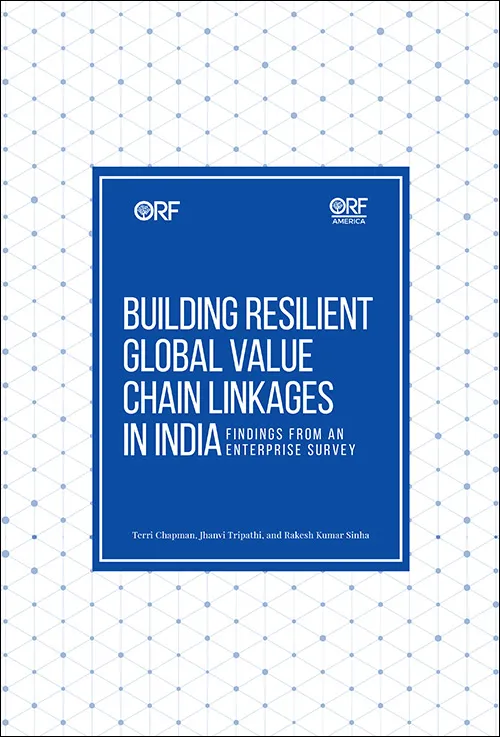Executive Summary
The risk of supply chain shocks has never been more palpable than today, following compounding crises from the US-China trade war, the COVID-19 pandemic, and the war in Ukraine. Global Value Chains (GVCs), once viewed as a panacea for economic development, are coming under increased scrutiny in different parts of the world. Increasingly complex, cross-border production processes are exposing companies and populations to a multitude of risks. At the same time, it is becoming clearer that greater integration into GVCs does not inevitably lead to improved economic outcomes or shared prosperity, especially for developing countries.
This report examines how India can better integrate into GVCs while building resilience. The report draws on a survey of executives from 200 domestic and foreign companies in India across six sectors: aerospace and defence; automotive and auto-components; capital goods; electronic systems design and manufacturing (ESDM); new and renewable energy; and pharmaceuticals and medical devices. The report presents insights into these companies’ perceptions of GVCs amidst immense disruptions from different causes. It describes the firms’ views on India’s trade policy, and summarises the key challenges facing these enterprises in scaling production and integrating into GVCs in India. The report makes recommendations for policy intervention in eight areas, and outlines strategies for incorporating resilience into India’s GVC linkages.
Key Survey Findings:
- Despite risks and uncertainties, enterprises consider further integration into GVCs as being critical for India. The current geopolitical climate, especially as companies search for alternatives to China, offers a window of opportunity for India to attract GVCs looking for new production homes. A particularly salient opportunity is if India can offer an environment that is conducive to resilience.
- Geopolitical developments inform investment decisions in India. Companies are currently reconsidering their value chains and the distribution of their production between countries. India can leverage this opportunity but must get the fundamentals right.
- India’s attractiveness vis-à-vis other countries depends on its ability to improve the business climate. Investments in human capital development and infrastructure will be critical and will have co-benefits with other domestic priorities.
- Industry’s dependence on both imports and exports is high, but firms say relatively less attention has been paid to import challenges, which they view as crucial.
- Companies agree that India must re-evaluate its trade policies. Trade policy is essential to successful GVC integration, and India’s recent trade agreements with the United Arab Emirates (UAE) and Australia are a testament to the country’s willingness to enhance and deepen trade relationships despite its aversion to the Regional Comprehensive Economic Partnership (RCEP). Companies agree that India should prioritise a trade deal with the United States.
- Enterprises continue to face domestic policy challenges. The most difficult obstacles to efforts in scaling up production in India include complex tax policies and procedures, the quality of infrastructure, and uncertainty in trade policy.
- Government support is needed to facilitate GVC integration. The most significant constraints to firms in participating in GVCs are meeting quality standards, lack of institutional support, and inadequate information. The government has a clear role in supporting enterprises in these areas.
- Companies have clear domestic policy priorities in India. Companies say that in the medium term, India should focus on enhancing its digital and physical infrastructure, strengthening financial and investment regulations, and ensuring clarity and certainty around trade policies and tariff rules.
If managed well, greater integration into GVCs can support economic growth, increase productivity, and facilitate the transfer of knowledge and technology. This report outlines strategies for India to create stronger GVC linkages and ensure that in its efforts to better amalgamate into GVCs, it is building resilience.
Introduction
J.S. Deepak
Advanced manufacturing techniques, including computer-aided design, allow product design codification and the standardisation of components. This, in turn, allows companies to standardise production and assembly. As such, the product's design, production, and assembly can be carried out separately in different parts of the world, with pieces of the same product being manufactured or assembled in different countries. This has led to the emergence of global value chains (GVCs), where lead firms, mostly multinational corporations (MNCs) from advanced economies, maximise competitiveness by outsourcing production and assembly to the lowest-cost destinations.
Since GVCs account for a growing proportion of global value addition, countries that are part of a key GVC can benefit from job and wealth creation. At the same time, countries wanting to be part of GVCs need skilled human resources and a supportive policy and business environment. Moreover, since items move between different countries during the production process, sometimes multiple times, trade plays an essential role in manufacturing products in GVCs. Zero tariffs and trade facilitation measures, in particular, are critical to saving cost and time.
Since production and assembly are done based on standardised templates, it becomes possible for lead MNCs to substitute firms manufacturing components or doing assembly-line production to enhance competitiveness. This diversification of supply helps build reliable supply chains. Furthermore, the critical role and reliability of every country that is part of the global value chain also makes it essential for MNCs to diversify supply chains across countries to make them more resilient to shocks such as the COVID-19 pandemic, climate-related disasters, or conflict.
Typically, the upper end of GVCs, which involves research and development (R&D), design, services, and marketing (that have intellectual property rights embedded in them) are profit-intensive; these components also tend to be located in advanced economies. The lower parts of the GVCs, meanwhile, tend to be labour-intensive and have lower-value addition, and are typically located in developing countries. GVCs give manufacturing a fillip, bring in infrastructure, develop skills, and increase exports, thereby serving as catalysts for increasing local incomes and economic growth. However, GVC integration does not automatically result in direct economic benefits such as job creation and improved living standards, and therefore policy has an important role to play in ensuring the best possible outcomes.
Trade, one of the engines of growth, has not been fully leveraged in India in the last decade. Merchandise exports that create jobs in manufacturing have remained flat, at around US$ 300 billion annually.
<1> It is noteworthy that India's trade as a percentage of GDP has plummeted from 56 percent in 2011 to 40 percent in 2019—the last year before the COVID-19 pandemic. While India's trade has picked up in 2021, mainly due to increased demand and the price effect, sustaining current levels will be challenging. Indeed, trade recovery is likely to slow down further as a result of the ongoing crisis in Ukraine.
India has not been part of significant trade blocs and is thus a latecomer to the GVC space. One of the main reasons for this is that GVCs thrive across geographies that liberalise trade with each other by reducing tariff and non-tariff barriers, actively implementing trade facilitation measures, and protecting investments. These measures are usually part of Free Trade Agreements (FTAs). Today, the ‘spaghetti bowl’ of FTAs
<2> includes about 500 arrangements with linkages and overlaps. Latin American countries, the European Union, ASEAN, Japan, and even China, aggressive traders, have many plurilateral and mega regional trade arrangements that facilitate GVCs.
To be sure, being a massive market with a young population makes India attractive. However, it needs to quickly catch up on specific essential criteria like tariffs, logistics, and trade and investment facilitation measures that allow GVCs to function seamlessly. India has also recently decided to pursue preferential trade agreements aggressively, which will support integration into GVCs.
The US-China trade war has already created further opportunities for India to become part of major GVCs. MNCs headquartered in the United States (US) previously established bases in China to leverage their infrastructure, skills, and low factor cost to manufacture at globally competitive rates and export to the US. Thus, a large proportion of global production of steel, consumer durables, textiles and clothing, shoes, and electronics became concentrated in China. However, with the trade war resulting in the imposition of tariffs on imports from China, many MNCs are looking for alternative locations for manufacturing these goods and reducing their risks by diversifying their sources of supply.
The COVID-19 pandemic has caused many bottlenecks in logistics networks, export restrictions on raw materials, intermediates, and supplies, playing havoc on the efficient functioning of GVCs. This has accentuated the need for both reshoring and diversification of sources of supply to make GVCs function efficiently with just-in-time availability of parts and components. Consequently, there is an urgent move globally to look for alternative destinations for manufacturing to increase the resilience of GVCs.
This is an opportunity that India cannot afford to ignore. A package of incentives, responsive governance, improved infrastructure and logistics, reduced tariffs, and seamless facilitation of imports and exports needs to be urgently unveiled. Some aspects like an ambitious Production Linked Incentive (PLI) scheme are already in place, while others still need to be implemented.
The US-China trade war and the COVID-19 pandemic exposed severe vulnerabilities in production networks of many important products and have made it imperative to reconfigure supply chains. The leaders of the Quad—i.e., Australia, India, Japan, and the United States—at their virtual summit in March 2021 underlined the need for reliable and resilient supply chains.
<3> The call came as part of efforts to stimulate manufacturing as the COVID-19 pandemic broke out. It also resonated in various leaders’ statements, especially in the US and India. At the time of writing this report, the omicron-led wave appears to be receding, but there is continuing uncertainty posed by the threat of future variants. Meanwhile, the Ukraine crisis has created new challenges for supply chains and international trade, severely impacting the energy and food sectors.
<4> Building more agile and robust supply chains has taken on new urgency as a matter of security as well.
This report is based on a survey of 200 domestic and foreign firms doing business in India on their experiences, expectations, and priorities related to GVCs in India. It seeks to address the following questions:
i) How are geopolitical developments affecting firms’ perceptions of GVCs, their relative importance, and the attractiveness of India vis-à-vis other countries?
ii) What constraints are firms in India facing in integrating into GVCs and what are their imperatives?
iii) What kind of ecosystem does India need to establish to create better GVC linkages, and what policies should the country prioritise to achieve this?
The rest of the report is structured as follows. Section 2 outlines the methodology used in the report, and Section 3 highlights key findings from the survey and discusses implications for Indian policymaking. The last section consolidates findings from the survey into eight policy intervention areas for India and nine strategies for building resilience into India’s GVC linkages.
Methodology
The methodology for this report involved identifying key stakeholders across six critical industrial sectors and seeking their views, through a structured questionnaire, on what needs to be done to integrate India into GVCs.
To identify potential survey respondents, the authors shortlisted ten industries based on the “champion sectors” defined by India’s Department of Promotion of Industry and Internal Trade, Ministry of Commerce.
<5> The authors further narrowed the focus of the sample to six industries of particular interest for this research: 1) aerospace and defence; 2) automotive and auto-components; 3) capital goods; 4) electronic systems design and manufacturing (ESDM); 5) new and renewable energy; and 6) pharmaceuticals and medical devices. The sample of companies included in the study include both foreign multinational companies (MNCs) as well as domestic firms, all of which have a presence in India. The sample of companies were identified by a third-party survey company. The companies were selected based on their sector, their presence in India, and their potential or current participation in GVCs.
The survey respondents were selected based on their working knowledge of the selected companies' strategic and international direction and constraints. Therefore, respondents comprised a range of individuals, including those in-charge of public policy, external affairs, government relations, global policy, international business, corporate affairs, and corporate strategy, as well as country heads and chief economists.
The survey questionnaire was developed by researchers at the Observer Research Foundation, Delhi, and the Observer Research Foundation America in Washington, DC. It was written in English and comprised 27 multiple-choice and open-ended questions. The questionnaire was converted into a digital questionnaire by a third-party data collection firm. A pilot of ten interviews was undertaken to ensure the quality of the questionnaire.
The survey was administered over the phone to 196 respondents, and over email to four. The researchers received 200 complete responses that met all inclusion criteria—i.e., the sector, designation of the respondent, and presence in India. Figure 1 shows the details of the survey respondents.
Read the entire report here.
<1> TrendEconomy. “
India | Imports and Exports | World | ALL COMMODITIES | Value (US$) | 2009 - 2020,” 2021.
<2> The ‘spaghetti bowl’ effect was a term coined by Jagdish Bhagwati to explain the tangle created by cross-cutting trade and tariff rules created by the signing of multiple Free Trade Agreements. He argues that it creates confusion in trading rules. (Jagdish Bhagwati, “US Trade Policy:
The Infatuation with FTAs”, Discussion Paper Series No. 726 Columbia University (April 1995) Jagdish Bhagwati. “
US Trade Policy: The Infatuation with FT As,” 1995.
<3> The White House. “
Quad Leaders’ Joint Statement: ‘the Spirit of the Quad” The White House, 2021.
<4> World Bank. “
The Impact of the War in Ukraine on Global Trade and Investment,” 2022.
<5> “
List of 27 Champion Sectors Manufacturing Sectors under DPIIT,” n.d.
The views expressed above belong to the author(s). ORF research and analyses now available on Telegram! Click here to access our curated content — blogs, longforms and interviews.

 PDF Download
PDF Download







.png)
.png)